How To Find The Critical Value Of F
4.ane: Extreme Values of Functions
- Folio ID
- 8237
Learning Objectives
- Ascertain absolute extrema.
- Define local extrema.
- Explain how to find the critical points of a office over a closed interval.
- Describe how to utilize critical points to locate accented extrema over a closed interval.
Given a detail office, we are often interested in determining the largest and smallest values of the function. This information is important in creating authentic graphs. Finding the maximum and minimum values of a function likewise has practical significance, considering we tin can utilise this method to solve optimization issues, such as maximizing profit, minimizing the amount of cloth used in manufacturing an aluminum can, or finding the maximum height a rocket tin reach. In this section, we look at how to use derivatives to find the largest and smallest values for a function.
Absolute Extrema
Consider the function \(f(x)=x^two+1\) over the interval \((−∞,∞)\). As \(x→±∞, f(x)→∞\).FN Therefore, the role does non have a largest value. However, since \(x^ii+one≥1\) for all existent numbers \(x\) and \(10^2+1=1\) when \(10=0\), the function has a smallest value, \(1\), when \(x=0\). Nosotros say that \(ane\) is the absolute minimum of \(f(x)=x^2+1\) and it occurs at \(10=0\). We say that \(f(x)=x^two+1\) does not take an absolute maximum (Figure \(\PageIndex{i}\)).
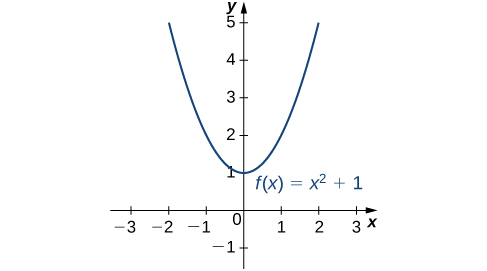
Definition: Accented Extrema
Allow \(f\) be a function defined over an interval \(I\) and let \(c∈I\). Nosotros say \(f\) has an absolute maximum on \(I\) at \(c\) if \(f(c)≥f(x)\) for all \(x∈I\). We say \(f\) has an absolute minimum on \(I\) at \(c\) if \(f(c)≤f(x)\) for all \(x∈I\). If \(f\) has an accented maximum on \(I\) at \(c\) or an absolute minimum on \(I\) at \(c\), we say \(f\) has an accented extremum on \(I\) at \(c\).
Earlier proceeding, let's notation 2 important issues regarding this definition. First, the term absolute here does non refer to absolute value. An accented extremum may be positive, negative, or zero. Second, if a office \(f\) has an absolute extremum over an interval \(I\) at \(c\), the absolute extremum is \(f(c)\). The existent number c is a point in the domain at which the absolute extremum occurs. For instance, consider the function \(f(x)=1/(x^ii+1)\) over the interval \((−∞,∞)\). Since
\[f(0)=1≥\frac{1}{x^2+1}=f(x)\]
for all real numbers \(10\), nosotros say \(f\) has an absolute maximum over \((−∞,∞)\) at \(10=0\). The absolute maximum is \(f(0)=1\). Information technology occurs at \(10=0\), equally shown in Figure \(\PageIndex{2}\)(b).
A office may have both an accented maximum and an absolute minimum, just i extremum, or neither. Effigy \(\PageIndex{2}\) shows several functions and some of the different possibilities regarding absolute extrema. However, the following theorem, called the Extreme Value Theorem, guarantees that a continuous role \(f\) over a airtight, bounded interval \([a,b]\) has both an accented maximum and an absolute minimum.
![This figure has half-dozen parts a, b, c, d, e, and f. In figure a, the line f(ten) = ten^three is shown, and information technology is noted that it has no absolute minimum and no accented maximum. In figure b, the line f(x) = 1/(10^2 + 1) is shown, which is most 0 for almost of its length and rises to a bump at (0, 1); information technology has no accented minimum, but does accept an absolute maximum of 1 at ten = 0. In figure c, the line f(x) = cos x is shown, which has accented minimums of −1 at ±π, ±3π, … and absolute maximums of one at 0, ±2π, ±4π, …. In figure d, the piecewise function f(ten) = ii – x^2 for 0 ≤ x < 2 and x – 3 for 2 ≤ x ≤ 4 is shown, with absolute maximum of 2 at x = 0 and no absolute minimum. In figure e, the function f(x) = (x – 2)2 is shown on [1, 4], which has absolute maximum of 4 at x = 4 and absolute minimum of 0 at x = 2. In figure f, the function f(x) = x/(2 − x) is shown on [0, 2), with absolute minimum of 0 at x = 0 and no absolute maximum.](https://math.libretexts.org/@api/deki/files/2406/CNX_Calc_Figure_04_03_010.jpeg?revision=1&size=bestfit&width=923&height=900)
Theorem \(\PageIndex{ane}\): Extreme Value Theorem
If \(f\) is a continuous function over the closed, bounded interval \([a,b]\), then at that place is a point in \([a,b]\) at which \(f\) has an absolute maximum over \([a,b]\) and there is a signal in \([a,b]\) at which \(f\) has an accented minimum over \([a,b]\).
The proof of the extreme value theorem is beyond the scope of this text. Typically, information technology is proved in a course on existent assay. There are a couple of key points to annotation virtually the statement of this theorem. For the extreme value theorem to apply, the function must be continuous over a closed, divisional interval. If the interval \(I\) is open up or the function has even ane point of discontinuity, the function may not accept an absolute maximum or accented minimum over \(I\). For example, consider the functions shown in Effigy \(\PageIndex{two}\) (d), (e), and (f). All three of these functions are divers over bounded intervals. However, the function in graph (e) is the merely one that has both an absolute maximum and an absolute minimum over its domain. The extreme value theorem cannot exist practical to the functions in graphs (d) and (f) because neither of these functions is continuous over a closed, bounded interval. Although the function in graph (d) is defined over the closed interval \([0,4]\), the function is discontinuous at \(x=2\). The function has an absolute maximum over \([0,4]\) but does not accept an accented minimum. The function in graph (f) is continuous over the half-open interval \([0,ii)\), but is not divers at \(x=2\), and therefore is not continuous over a closed, bounded interval. The role has an accented minimum over \([0,2)\), but does not take an absolute maximum over \([0,2)\). These two graphs illustrate why a function over a bounded interval may fail to have an absolute maximum and/or absolute minimum.
Before looking at how to find absolute extrema, permit's examine the related concept of local extrema. This idea is useful in determining where accented extrema occur.
Local Extrema and Critical Points
Consider the function \(f\) shown in Figure \(\PageIndex{3}\). The graph can be described equally two mountains with a valley in the middle. The accented maximum value of the role occurs at the college tiptop, at \(x=2\). Even so, \(x=0\) is too a point of interest. Although \(f(0)\) is not the largest value of \(f\), the value \(f(0)\) is larger than \(f(x)\) for all \(x\) near 0. We say \(f\) has a local maximum at \(x=0\). Similarly, the office \(f\) does not take an absolute minimum, merely it does take a local minimum at \(x=i\) because \(f(ane)\) is less than \(f(x)\) for \(x\) near 1.
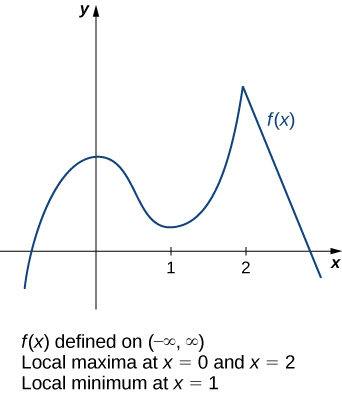
Definition: Local Extrema
A role \(f\) has a local maximum at \(c\) if there exists an open interval \(I\) containing \(c\) such that \(I\) is independent in the domain of \(f\) and \(f(c)≥f(ten)\) for all \(10∈I\). A function \(f\) has a local minimum at \(c\) if at that place exists an open interval \(I\) containing \(c\) such that \(I\) is independent in the domain of \(f\) and \(f(c)≤f(x)\) for all \(ten∈I\). A function \(f\) has a local extremum at \(c\) if \(f\) has a local maximum at \(c\) or \(f\) has a local minimum at \(c\).
Note that if \(f\) has an accented extremum at \(c\) and \(f\) is defined over an interval containing \(c\), then \(f(c)\) is also considered a local extremum. If an accented extremum for a office \(f\) occurs at an endpoint, we practice not consider that to be a local extremum, simply instead refer to that as an endpoint extremum.
Given the graph of a role \(f\), information technology is sometimes easy to see where a local maximum or local minimum occurs. However, it is not always easy to come across, since the interesting features on the graph of a part may not be visible because they occur at a very pocket-sized scale. Likewise, we may non have a graph of the function. In these cases, how can we apply a formula for a role to decide where these extrema occur?
To reply this question, permit'due south look at Effigy \(\PageIndex{3}\) again. The local extrema occur at \(x=0, x=one,\) and \(ten=two.\) Notice that at \(x=0\) and \(x=ane\), the derivative \(f'(10)=0\). At \(x=ii\), the derivative \(f'(ten)\) does not exist, since the function \(f\) has a corner at that place. In fact, if \(f\) has a local extremum at a signal \(10=c\), the derivative \(f'(c)\) must satisfy one of the following conditions: either \(f'(c)=0\) or \(f'(c)\) is undefined. Such a value \(c\) is known as a critical point and it is of import in finding farthermost values for functions.
Definition: Critical Points
Let \(c\) be an interior signal in the domain of \(f\). Nosotros say that \(c\) is a critical point of \(f\) if \(f'(c)=0\) or \(f'(c)\) is undefined.
As mentioned before, if \(f\) has a local extremum at a point \(ten=c\), then \(c\) must be a critical point of \(f\). This fact is known as Fermat's theorem.
Theorem \(\PageIndex{2}\): Fermat's Theorem
If \(f\) has a local extremum at \(c\) and \(f\) is differentiable at \(c\), then \(f'(c)=0.\)
Proof
Suppose \(f\) has a local extremum at \(c\) and \(f\) is differentiable at \(c\). Nosotros need to evidence that \(f'(c)=0\). To do this, we volition show that \(f'(c)≥0\) and \(f'(c)≤0\), and therefore \(f'(c)=0\). Since \(f\) has a local extremum at \(c\), \(f\) has a local maximum or local minimum at \(c\). Suppose \(f\) has a local maximum at \(c\). The case in which \(f\) has a local minimum at \(c\) can be handled similarly. There then exists an open interval I such that \(f(c)≥f(x)\) for all \(x∈I\). Since \(f\) is differentiable at \(c\), from the definition of the derivative, we know that
\[f'(c)=\lim_{x→c}\frac{f(x)−f(c)}{x−c}.\]
Since this limit exists, both one-sided limits besides exist and equal \(f'(c)\). Therefore,
\[f'(c)=\lim_{x→c^+}\frac{f(x)−f(c)}{x−c,}\]
and
\[f'(c)=\lim_{10→c^−}\frac{f(x)−f(c)}{x−c}.\]
Since \(f(c)\) is a local maximum, we run into that \(f(x)−f(c)≤0\) for \(x\) near \(c\). Therefore, for \(x\) nearly \(c\), but \(x>c\), nosotros accept \(\frac{f(10)−f(c)}{x−c}≤0\). From Equation nosotros conclude that \(f'(c)≤0\). Similarly, it can be shown that \(f'(c)≥0.\) Therefore, \(f'(c)=0.\)
□
From Fermat's theorem, we conclude that if \(f\) has a local extremum at \(c\), then either \(f'(c)=0\) or \(f'(c)\) is undefined. In other words, local extrema can simply occur at disquisitional points.
Note this theorem does non claim that a part \(f\) must accept a local extremum at a disquisitional point. Rather, information technology states that critical points are candidates for local extrema. For example, consider the part \(f(x)=x^iii\). We have \(f'(x)=3x^2=0\) when \(ten=0\). Therefore, \(x=0\) is a disquisitional bespeak. Withal, \(f(10)=x^three\) is increasing over \((−∞,∞)\), and thus \(f\) does not take a local extremum at \(x=0\). In Figure \(\PageIndex{4}\), we see several different possibilities for critical points. In some of these cases, the functions have local extrema at critical points, whereas in other cases the functions do non. Annotation that these graphs practice not bear witness all possibilities for the behavior of a function at a critical indicate.
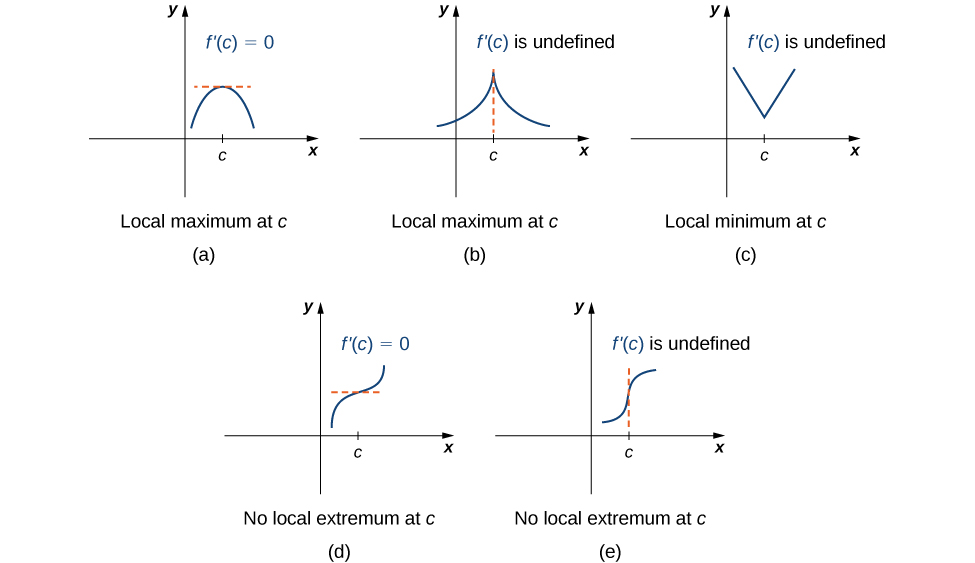
Later in this affiliate we look at analytical methods for determining whether a part actually has a local extremum at a critical point. For now, let'southward turn our attention to finding critical points. We volition apply graphical observations to determine whether a critical point is associated with a local extremum.
Example \(\PageIndex{one}\): Locating Critical Points
For each of the following functions, find all critical points. Utilize a graphing utility to decide whether the function has a local extremum at each of the critical points.
- \(f(ten)=\frac{i}{3}x^3−\frac{5}{2}10^2+4x\)
- \(f(x)=(x^ii−1)^three\)
- \(f(10)=\frac{4x}{1+10^two}\)
Solution
a. The derivative \(f'(x)=x^2−5x+4\) is defined for all existent numbers \(x\). Therefore, we but need to find the values for \(ten\) where \(f'(x)=0\). Since \(f'(x)=x^2−5x+4=(x−4)(ten−1)\), the critical points are \(x=ane\) and \(x=iv.\) From the graph of \(f\) in Figure \(\PageIndex{five}\), we see that \(f\) has a local maximum at \(x=i\) and a local minimum at \(ten=4\).

b. Using the chain dominion, we see the derivative is
\(f'(x)=3(x^2−ane)^2(2x)=6x(x^two−1)^2.\)
Therefore, \(f\) has critical points when \(x=0\) and when \(10^two−i=0\). Nosotros conclude that the critical points are \(x=0,±1\). From the graph of \(f\) in Figure \(\PageIndex{6}\), we see that \(f\) has a local (and absolute) minimum at \(ten=0\), but does not have a local extremum at \(10=1\) or \(x=−1\).
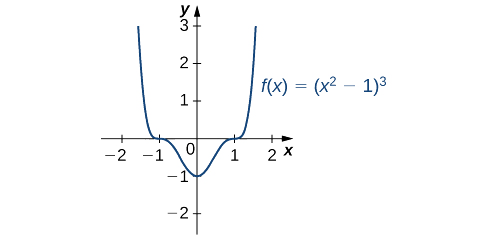
c. Past the chain dominion, we see that the derivative is
\(f'(x)=\frac{(1+x^24)−4x(2x)}{(1+10^2)^2}=\frac{4−4x^2}{(ane+10^2)^2}\).
The derivative is divers everywhere. Therefore, we but need to find values for \(ten\) where \(f'(10)=0\). Solving \(f'(x)=0\), we see that \(four−4x^ii=0,\) which implies \(ten=±1\). Therefore, the critical points are \(x=±ane\). From the graph of \(f\) in Figure \(\PageIndex{vii}\), we run across that f has an absolute maximum at \(x=1\) and an absolute minimum at \(10=−ane.\) Hence, \(f\) has a local maximum at \(x=1\) and a local minimum at \(10=−ane\). (Note that if \(f\) has an absolute extremum over an interval \(I\) at a point \(c\) that is not an endpoint of \(I\), so \(f\) has a local extremum at \(c.)\)
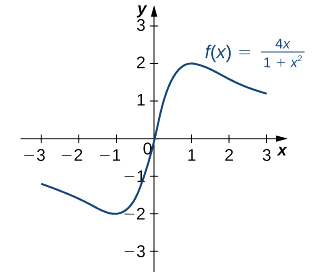
Exercise \(\PageIndex{1}\)
Discover all critical points for \(f(x)=10^3−\frac{1}{ii}x^2−2x+1.\)
- Hint
-
Calculate \(f'(x).\)
- Answer
-
\(x=−23, x=1\)
Locating Accented Extrema
The farthermost value theorem states that a continuous function over a closed, bounded interval has an accented maximum and an accented minimum. As shown in Figure \(\PageIndex{2}\), ane or both of these absolute extrema could occur at an endpoint. If an accented extremum does not occur at an endpoint, however, it must occur at an interior point, in which instance the absolute extremum is a local extremum. Therefore, past Fermat's Theorem, the point \(c\) at which the local extremum occurs must exist a critical signal. Nosotros summarize this result in the post-obit theorem.
Theorem \(\PageIndex{3}\): Location of Accented Extrema
Let \(f\) be a continuous role over a closed, bounded interval \(I\). The absolute maximum of \(f\) over \(I\) and the absolute minimum of \(f\) over \(I\) must occur at endpoints of \(I\) or at disquisitional points of \(f\) in \(I\).
With this idea in heed, let's examine a procedure for locating absolute extrema.
Problem-Solving Strategy: Locating Absolute Extrema over a Closed Interval
Consider a continuous office \(f\) divers over the closed interval \([a,b].\)
- Evaluate \(f\) at the endpoints \(x=a\) and \(10=b.\)
- Notice all critical points of \(f\) that prevarication over the interval \((a,b)\) and evaluate \(f\) at those critical points.
- Compare all values found in (1) and (ii). From Note, the accented extrema must occur at endpoints or critical points. Therefore, the largest of these values is the absolute maximum of \(f\). The smallest of these values is the absolute minimum of \(f\).
Now permit's look at how to utilise this strategy to notice the accented maximum and accented minimum values for continuous functions.
Example \(\PageIndex{two}\): Locating Absolute Extrema
For each of the following functions, find the accented maximum and accented minimum over the specified interval and state where those values occur.
- \(f(x)=−x^two+3x−ii\) over \([1,3].\)
- \(f(10)=x^2−3x^{2/3}\) over \([0,2]\).
Solution
a. Stride 1. Evaluate \(f\) at the endpoints \(x=1\) and \(x=three\).
\(f(1)=0\) and \(f(3)=−2\)
Step 2. Since \(f'(x)=−2x+iii, f'\) is divers for all existent numbers 10. Therefore, in that location are no critical points where the derivative is undefined. It remains to check where \(f'(x)=0\). Since \(f'(ten)=−2x+3=0 \)at \(x=\frac{3}{2}\) and \(\frac{3}{ii}\) is in the interval \([1,3], f(\frac{three}{2})\) is a candidate for an accented extremum of \(f\) over \([one,iii]\). Nosotros evaluate \(f(\frac{three}{2})\) and notice
\(f\left(\frac{iii}{2}\right)=\frac{1}{4}\).
Step 3. We set upwardly the following table to compare the values found in steps 1 and 2.
| \(x\) | \(f(x)\) | Conclusion |
| \(0\) | \(0\) | |
| \(\frac{three}{2}\) | \(\frac{1}{4}\) | Accented maximum |
| \(three\) | \(−ii\) | Absolute minimum |
From the tabular array, we discover that the absolute maximum of \(f\) over the interval [ane, three] is \(\frac{1}{4}\), and it occurs at \(x=\frac{3}{2}\). The absolute minimum of \(f\) over the interval \([1, three]\) is \(−2\), and it occurs at \(ten=3\) as shown in Figure \(\PageIndex{8}\).
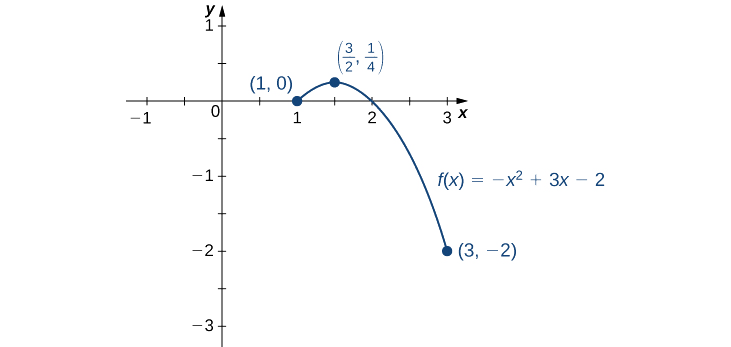
b. Stride 1. Evaluate \(f\) at the endpoints \(10=0\) and \(10=two\).
\(f(0)=0\) and \(f(2)=4−3\left(2\right)^{2/3}≈−0.762\)
Footstep 2. The derivative of \(f\) is given by
\(f'(x)=2x−\frac{2}{x^{1/3}}=\dfrac{2x^{iv/three}−2}{x^{ane/iii}}\)
for \(x≠0\). The derivative is naught when \(2x^{4/iii}−2=0\), which implies \(x=±one\). The derivative is undefined at \(10=0\). Therefore, the critical points of \(f\) are \(ten=0,one,−1\). The betoken \(x=0\) is an endpoint, and so we already evaluated \(f(0)\) in stride 1. The bespeak \(10=−i\) is not in the interval of interest, so we need only evaluate \(f(1)\). Nosotros find that
\(f(1)=−2.\)
Step 3. We compare the values establish in steps 1 and ii, in the following tabular array.
| \(x\) | \(f(x)\) | Conclusion |
| \(0\) | \(0\) | Absolute maximum |
| \(1\) | \(−2\) | Absolute minimum |
| \(ii\) | \(−0.762\) |
Nosotros conclude that the absolute maximum of \(f\) over the interval [0, two] is zero, and it occurs at \(x=0\). The absolute minimum is −2, and it occurs at \(x=ane\) as shown in Figure \(\PageIndex{9}\).
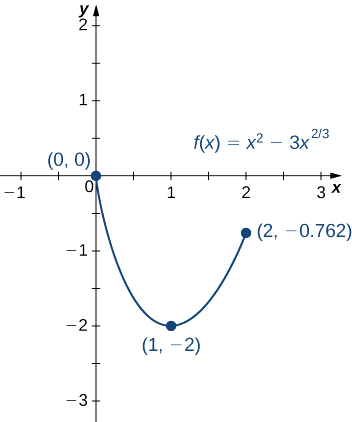
Exercise \(\PageIndex{2}\)
Notice the absolute maximum and absolute minimum of \((x)=x^2−4x+three\) over the interval \([1,4]\).
- Hint
-
Look for critical points. Evaluate \(f\) at all critical points and at the endpoints.
- Reply
-
The accented maximum is \(iii\) and it occurs at \(x=iv\). The absolute minimum is \(−1\) and it occurs at \(x=ii\).
At this point, nosotros know how to locate absolute extrema for continuous functions over closed intervals. We have also divers local extrema and determined that if a function \(f\) has a local extremum at a point \(c\), then \(c\) must be a critical bespeak of \(f\). However, \(c\) being a critical point is not a sufficient status for \(f\) to have a local extremum at \(c\). Later in this affiliate, we testify how to determine whether a function really has a local extremum at a critical point. Get-go, still, we demand to innovate the Mean Value Theorem, which will help equally nosotros clarify the behavior of the graph of a function.
Key Concepts
- A function may have both an absolute maximum and an absolute minimum, have just 1 absolute extremum, or have no absolute maximum or absolute minimum.
- If a role has a local extremum, the point at which it occurs must exist a critical signal. Nevertheless, a function need not have a local extremum at a disquisitional bespeak.
- A continuous function over a closed, bounded interval has an absolute maximum and an absolute minimum. Each extremum occurs at a critical indicate or an endpoint.
Glossary
- absolute extremum
- if \(f\) has an absolute maximum or absolute minimum at \(c\), we say \(f\) has an absolute extremum at \(c\)
- absolute maximum
- if \(f(c)≥f(x)\) for all \(x\) in the domain of \(f\), we say \(f\) has an absolute maximum at \(c\)
- absolute minimum
- if \(f(c)≤f(x)\) for all \(x\) in the domain of \(f\), we say \(f\) has an absolute minimum at \(c\)
- critical signal
- if \(f'(c)=0\) or \(f'(c)\) is undefined, nosotros say that c is a critical betoken of \(f\)
- farthermost value theorem
- if \(f\) is a continuous function over a finite, closed interval, then \(f\) has an accented maximum and an absolute minimum
- Fermat's theorem
- if \(f\) has a local extremum at \(c\), and so \(c\) is a critical indicate of \(f\)
- local extremum
- if \(f\) has a local maximum or local minimum at \(c\), nosotros say \(f\) has a local extremum at \(c\)
- local maximum
- if there exists an interval \(I\) such that \(f(c)≥f(x)\) for all \(x∈I\), we say \(f\) has a local maximum at \(c\)
- local minimum
- if there exists an interval \(I\) such that \(f(c)≤f(x)\) for all \(x∈I\), nosotros say \(f\) has a local minimum at \(c\)
Contributors and Attributions
-
Gilbert Strang (MIT) and Edwin "Jed" Herman (Harvey Mudd) with many contributing authors. This content past OpenStax is licensed with a CC-BY-SA-NC 4.0 license. Download for free at http://cnx.org.
Source: https://math.libretexts.org/Courses/University_of_California_Davis/UCD_Mat_21A%3A_Differential_Calculus/4%3A_Applications_of_Definite_Integrals/4.1%3A_Extreme_Values_of_Functions
Posted by: hillruslaideemin.blogspot.com


0 Response to "How To Find The Critical Value Of F"
Post a Comment